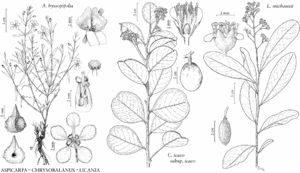Difference between revisions of "Chrysobalanaceae"
FNA>Volume Importer |
imported>Volume Importer |
||
| (5 intermediate revisions by 2 users not shown) | |||
| Line 50: | Line 50: | ||
-->{{#Taxon: | -->{{#Taxon: | ||
name=Chrysobalanaceae | name=Chrysobalanaceae | ||
| − | |author=R. David Whetstone; Christopher F. Nixon† | + | |author=R. David Whetstone;Christopher F. Nixon† |
|authority=R. Brown | |authority=R. Brown | ||
|rank=family | |rank=family | ||
| Line 57: | Line 57: | ||
|basionyms= | |basionyms= | ||
|family=Chrysobalanaceae | |family=Chrysobalanaceae | ||
| + | |illustrator=Marjorie C. Leggitt | ||
| + | |illustration copyright=Flora of North America Association | ||
|distribution=se United States;Mexico;West Indies;Central America;South America;s Asia;Africa;Pacific Islands;Australia. | |distribution=se United States;Mexico;West Indies;Central America;South America;s Asia;Africa;Pacific Islands;Australia. | ||
|reference=prance1970a;prance1972a;prance2003a | |reference=prance1970a;prance1972a;prance2003a | ||
| Line 62: | Line 64: | ||
|publication year= | |publication year= | ||
|special status= | |special status= | ||
| − | |source xml=https:// | + | |source xml=https://bitbucket.org/aafc-mbb/fna-data-curation/src/2e0870ddd59836b60bcf96646a41e87ea5a5943a/coarse_grained_fna_xml/V12/V12_883.xml |
}}<!-- | }}<!-- | ||
-->[[Category:Treatment]] | -->[[Category:Treatment]] | ||
Latest revision as of 19:18, 5 November 2020
Shrubs or trees, tardily deciduous to evergreen. Leaves alternate (2-ranked), simple; stipules present; petiole present, short; blade often coriaceous, margins entire or remotely toothed; venation pinnate. Inflorescences terminal or axillary, thyrses [cymes, racemes, or panicles]. Flowers bisexual; perianth and androecium perigynous; hypanthium free, well developed, densely hairy on both surfaces; sepals 5, distinct; petals [0 or 4–]5, distinct; nectary present, lining hypanthium; stamens [2–]14–22[–300], connate basally to proximally [distinct], free; anthers versatile, dehiscing by longitudinal slits; pistil 1, 3-carpellate with 1 [rarely 2–3] carpel developing, ovary superior, 1[–3]-locular, placentation basal; ovules 2 per locule, anatropous; style 1, basal; stigmas [1] 3. Fruits drupes. Seeds 1 per fruit.
Distribution
se United States, Mexico, West Indies, Central America, South America, s Asia, Africa, Pacific Islands, Australia.
Discussion
Genera 18, species ca. 530 (2 genera, 2 species in the flora).
Chrysobalanaceae was traditionally considered a subfamily of the Rosaceae. Family status is supported by morphology (G. T. Prance 1972; Prance and C. A. Sothers 2003) and molecular data, which place it as a member of the Malpighiales and thus not closely related to the Rosaceae (see, for example, M. W. Chase et al. 1993; N. Korotkova et al. 2009; K. Wurdack and C. C. Davis 2009). Only Chrysobalanus icaco is important commercially; it is planted as an ornamental and its fruits are eaten raw or bottled in syrup and sold (A. Cronquist 1981).
Selected References
Lower Taxa
Illustrations
Key
| 1 | Shrubs or trees, 1–5 m; leaf blades broadly elliptic, broadly ovate, or broadly obovate, length 1.2–1.5 times width; stamen filaments densely hairy proximally; endocarps longitudinally ribbed. | Chrysobalanus |
| 1 | Shrubs, to 0.3(–0.5) m; leaf blades oblanceolate, lanceolate, or narrowly oblong, length 2.5–3.5 times width; stamen filaments glabrous; endocarps not longitudinally ribbed. | Licania |
